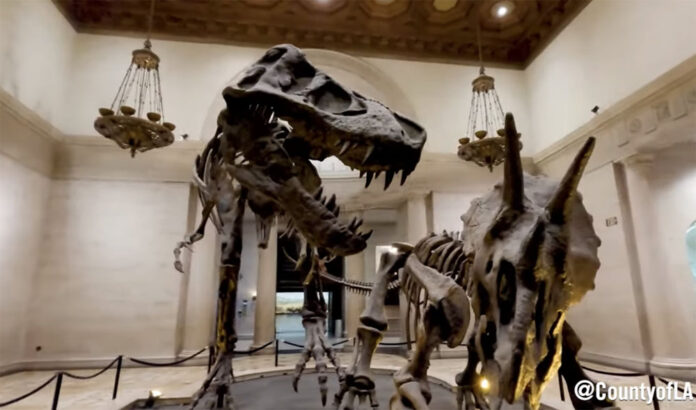by Zurellys Villegas
The Natural History Museum of Los Angeles (NHM) is preparing the fascinating exhibition of Gnatalie, the only green-boned dinosaur fossil on the planet.
Gnatalie was discovered in 2007 in the Utah Badlands by a team of researchers from the NHMLAC Dinosaur Institute, led by Dr. Luis Chiappe, NHMLAC Senior Vice President of Research and Collections and Gretchen Augustyn, Director of the Dinosaur Institute.
Dr. Chiappe states that “dinosaurs are a great vehicle to teach our visitors about the nature of science,” and at the same time highlights the importance of the exhibition for visitors by stating “what better than a green dinosaur almost 80 feet long to engage them in the process of scientific discovery and make them reflect on the wonders of the world we live in.”
Gnatalie, as it was recently named by the Angelenos, is a collection of several specimens, all belonging to a species of long-necked dinosaur (sauropod) similar to the diplodocus.
The NHM website explains that the long-necked, long-tailed herbivorous dinosaur fossils got their unique coloration, a mottled dark olive green, from the mineral celadonite during the fossilization process, unlike the fossils that are usually brown from silica or black from iron minerals.
Matt Wedel, an anatomist and paleontologist at Western University of Health Sciences in Pomona, near Los Angeles, referred to the unusual find, saying that he heard “rumors about a green dinosaur when I was in graduate school.”
He went on to say that he saw Gnatalie’s bones while they were still being cleaned and revealed that they were “like nothing I’ve ever seen in my life.”
For Professor John Whitlock, a sauropod expert at Mount Aloysius College, the discovery of the nearly complete skeleton of Gnatalie represents a milestone in paleontology, as it will allow for more accurate comparative studies and expand our knowledge of this dinosaur species.
“It’s tremendously huge, it really increases our ability to understand both the taxonomic and anatomical diversity,” said the sauropod expert.
Angelenos choose ‘Gnatalie’ as the dinosaur’s official name
Last June, residents of Los Angeles voted to choose Gnatalie (pronounced “nat-ah-lee”) as the official name of this specimen discovered in Utah in 2007. Gnatalie was the winning choice among five names included in the ballot proposed by the museum.
Verdi, a derivative of the Latin word for green; Olive, for the small green fruit that symbolizes peace, joy and strength in many cultures; Esme, short for Esmeralda, which means emerald in Spanish; and Sage, an iconic green plant from Los Angeles were the other options for the official name of the dinosaur that the NHM had.
Gnatalie fossils are at the Natural History Museum of Los Angeles
Gnatalie is a set composed of several specimens, all belonging to a species of long-necked dinosaur (sauropod) similar to the diplodocus, explains the museum.
Approximately 150 million years ago, during the late Jurassic, the fossil remains of this dinosaur were buried in the bed of a river, sharing this resting place with others of its same species. “The preservation of bones for more than 100 million years is incredibly rare, but Gnatalie is more extraordinary than most,” adds the gallery.
The largest specimen on display at the Museum, measuring more than 23 meters, can also be seen for free, with or without admission. Gnatalie will be the first green dinosaur skeleton to go on display anywhere in the world.
Los Angeles County residents will have the chance to see this rare specimen on display Monday through Friday from 3 to 5 p.m. this fall at the Natural History Museum at 900 Exposition Blvd., Los Angeles, CA 90007.
With Reporting by AP and NHM



